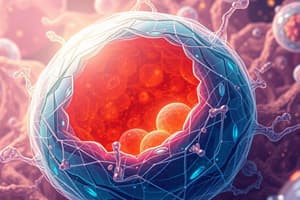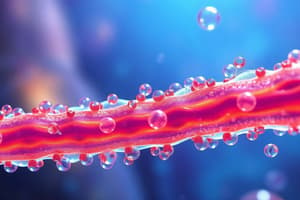Podcast
Questions and Answers
What is a primary function of the cell wall?
What is a primary function of the cell wall?
- Regulating cell division
- Facilitating nutrient absorption
- Providing shape and support (correct)
- Controlling cellular respiration
Which organisms generally do not have a cell wall?
Which organisms generally do not have a cell wall?
- Bacteria and archaea
- Animals and many animal-like protists (correct)
- Plants and fungi
- Algae and mosses
What is true about the nature of the cell wall?
What is true about the nature of the cell wall?
- It is a non-living component (correct)
- It is a living component
- It is flexible and can change shape easily
- It is composed mainly of lipids
What does the cell wall help to protect?
What does the cell wall help to protect?
Which characteristic is NOT associated with the cell wall?
Which characteristic is NOT associated with the cell wall?
Flashcards
Cell wall function
Cell wall function
The cell wall provides shape, strength, protection, and support to the cell's inner parts.
Cell wall location
Cell wall location
The cell wall is found outside the cell's plasma membrane.
Is cell wall living?
Is cell wall living?
No, the cell wall is a non-living component.
Cell wall's role in cells
Cell wall's role in cells
Signup and view all the flashcards
Organisms without cell wall
Organisms without cell wall
Signup and view all the flashcards
Study Notes
Cell Walls
- Not all living organisms have cell walls, some examples include animals and certain protists.
- Cell walls are non-living structures located outside the cell's plasma membrane.
- They provide shape and strength to the cell.
- Cell walls protect and support the cell's inner living material (protoplasm).
Studying That Suits You
Use AI to generate personalized quizzes and flashcards to suit your learning preferences.




